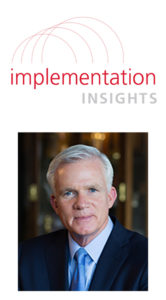
Craig Harper, Chief Operations Officer, J.B. Hunt Transport Services
J.B. Hunt Transport Services (NASDAQ: JBHT) is a $15 billion market cap transportation and logistics company headquartered in Arkansas. For the firm and its shareholders, reducing emissions and mitigating climate risk are key issues. As BlackRock detailed in an April voting bulletin, it supported J.B. Hunt’s management considering “the company has markedly improved its disclosures and has committed to publishing a SASB-aligned report by year-end.” J.B. Hunt’s landmark SASB report, the first for a road transportation company, was published in August 2020. In addition to using SASB Standards, the report sets out goals for reducing emissions and improving driver health. Craig Harper, J.B. Hunt’s chief operations officer with a 28-year career at the company, oversaw the company’s ESG transformation. He emailed these responses to SASB’s questions.
What has the journey been like for J.B. Hunt as you moved toward SASB reporting?
Internally, we had been very aware of the company’s efforts to improve the efficiency of our fleet and operations and reduce our carbon footprint; however, we realised that there was a disconnect between our internal understanding and public perception. Many of our stakeholders expressed that they wanted J.B. Hunt to provide more disclosure around our ESG efforts, and we recognised SASB reporting as a great opportunity to tell our story. Gathering the necessary data and information required a lot of time and effort from multiple teams within the company—safety, operations, legal, human resources, and marketing, just to name a few. It was quite an undertaking at first. However, our people were quick to jump on board as they understood the importance of transparency and viewed this as a way to demonstrate some of the ways we support our mission statement “to create the most efficient transportation network in North America.” The report we published recently is only a part of the company’s improved effort to be more transparent with ESG information, and we will continue to make advancements along this journey.
You have a lot of responsibility as both COO—keeping trucks on the road and freight moving—and as head of J.B. Hunt’s sustainability effort. Why did J.B. Hunt decide to place operational responsibility for ESG within the C-suite?
We have learned that having visible support from the C-suite truly helps disseminate the message and emphasise its importance. With this encouragement and support, others in the company are more likely to participate and engage early on. Many processes regarding efficiency, safety, and other measures are a part of J.B. Hunt’s fabric and were already being implemented. SASB Standards provided a solid framework to help us better disclose our initiatives in these areas, and with the strong support from company leaders, especially the C-suite, we were able to ensure the commitment of several functions within the company.
For a lot of companies, it can be a challenge convincing senior management that the benefits of ESG outweigh the costs of gathering data and reporting it publicly. What did it take to convince you and the rest of the C-suite?
Actually, it did not take much convincing. As it became apparent that many of our stakeholders, including investors, customers, and employees, were showing more and more interest in learning about J.B. Hunt’s work relating to ESG, the executive team quickly offered their support. J.B. Hunt has publicly expressed our commitment to reducing our carbon footprint, ensuring the safety of our people, and bettering the communities we serve while providing the transportation needs for our customers. As a company that values integrity and fairness, we hold to our commitments, even when times are uncertain.
In addition, we have established a culture at J.B. Hunt that emphasizes the importance of safety in day-to-day operations. The C-suite has been very open in addressing this and has often discussed our safety initiatives at investor conferences, industry events, and speaking engagements. We consider it our responsibility to do our part in keeping the nation’s highways safe and being good stewards to the community. It’s just part of our DNA. The C-suite has been very engaging on ESG topics during executive meetings and have been supportive of our efforts to be more transparent with our investors and other stakeholders.
What are some goals for further advancing your ESG reporting?
We want to expand the visibility of our ESG initiatives so that multiple stakeholders are aware of our commitment to sustainability. SASB Standards have really helped us identify and organize the data and information that we as a company need to disclose; however, SASB is mostly aligned with the investor community. As we continue this journey, we want to make sure additional stakeholders—employees, customers, and local communities, for example—are more informed about how J.B. Hunt is working to ensure a sustainable future for our business.
What advice do you have for companies that are beginning the process of integrating SASB Standards into their management and disclosure processes?
Set reasonable expectations and remember that this is a continuous journey, not a sprint. Don’t be intimidated or anticipate perfection out of the gate. Making the commitment to be more transparent with your sustainability efforts is a big step. Measure your success by the progress you make over the long term.
Previous SASB Implementation Insights:

